Dell U3011 Review: Dell's New 30-inch Flagship
by Brian Klug on January 13, 2011 9:17 PM ESTViewing Angles
The U3011 has superb viewing angles, just like we've grown accustomed to seeing from IPS panels. Even at the far extreme horizontally, there's none of the purple I'm used to seeing from TN panels as you move off-axis. In the vertical direction, I saw the same thing with almost nothing to complain about. I did notice some glare at the extreme angles, but again that's dependent on where you're sitting and where light sources are located.
I think this is an excellent opportunity to talk about IPS graininess, something we really haven't discussed before. Of the IPS panels I've used to date, all of them have had some high frequency grain on the surface from a combination of coating and interference at the interface. Thankfully the U3011 has a combination antireflection coating and hard coating, and subjectively there seems to be less grain than I've seen on other displays.
Color Quality
Next up are the ever-important color quality metrics. As usual, we report two main quality metrics: color accuracy (Delta-E) and color gamut. Color gamut refers to the range of colors the display is able to represent with respect to some color space. In this case, our reference is the AdobeRGB 1998 color space, which is larger than the sRGB color space. Our percentages are thus reported with respect to AdobeRGB 1998, and larger is generally better unless you're dealing with sRGB content and colorspace-unaware software.
Color accuracy (Delta E) refers to the display’s ability to display the correct color requested by the GPU and OS. The difference between the color represented by the display, and the color requested by the GPU is our Delta-E, and lower is better here. In practice, a Delta E under 1.0 is perfect - the chromatic sensitivity of the human eye is not great enough to distinguish a difference. Moving up, a Delta E of 2.0 or less is generally considered fit for use in a professional imaging environment - it isn’t perfect, but it’s hard to gauge the difference. Finally, Delta E of 4.0 and above is considered visible with the human eye. Of course, the big consideration here is frame of reference; unless you have another monitor or some print samples like a Gretag Macbeth color checker card to compare your display with, you might not notice.
As I mentioned in our earlier reviews, we’ve updated our display test bench. We’ve deprecated the Monaco Optix XR Pro colorimeter in favor of an Xrite i1D2 since there are no longer up-to-date drivers for modern platforms. We're trying to find an i1Pro to use as well.
For these tests, we calibrate the display and try to obtain the best Delta-E we can get at both 200 nits of brightness for normal use, and 100 nits for print brightness. We target D65 and a gamma of 2.2, but sometimes the best performance lies at native temperature and another gamma, so we try to find what absolute absolute best-case performance for each display. We also take an uncalibrated measurement to show performance out of the box using either the manufacturer supplied color profile, or a generic one with no LUT data. For all of these, dynamic contrast is disabled, and displays are left to settle for a half hour after making changes. The U3011 is CCFL-backlit, and I used a settle time of 30 minutes accordingly.
First up is uncalibrated Delta-E performance. For this test, I took the monitor out of the box, connected it over DisplayPort, adjusted to 200 nits, and ran our usual GMB color checker test. Results aren't that great, sadly.
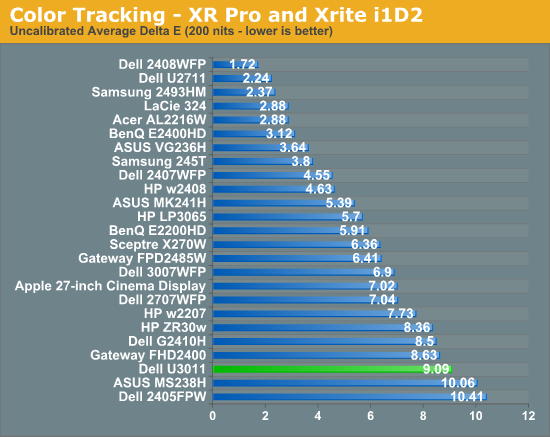
I mentioned earlier that the U3011 we got from Dell for testing came with no factory calibration report. After checking up with them, we learned this is a pre-production unit identical to what's shipping now, minus that factory calibration. That's something we can live with, especially since we recommend every display be calibrated, but still unnerving.
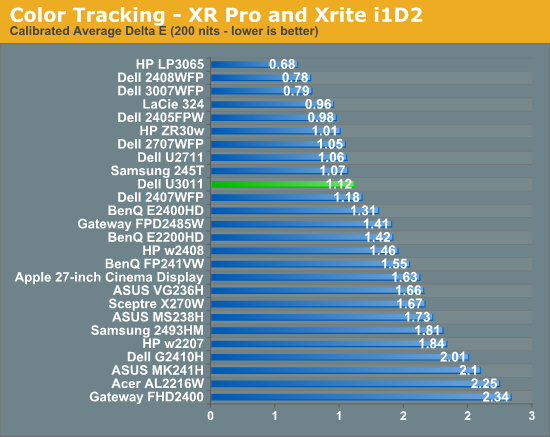
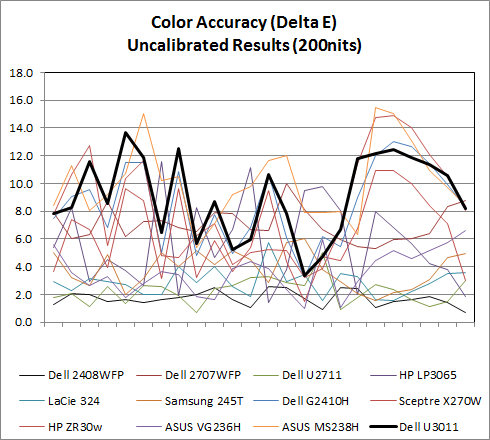
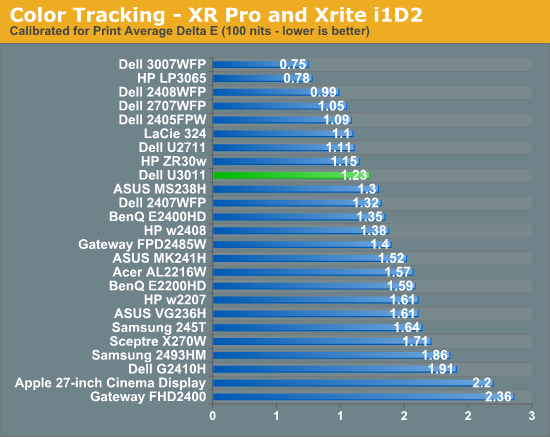
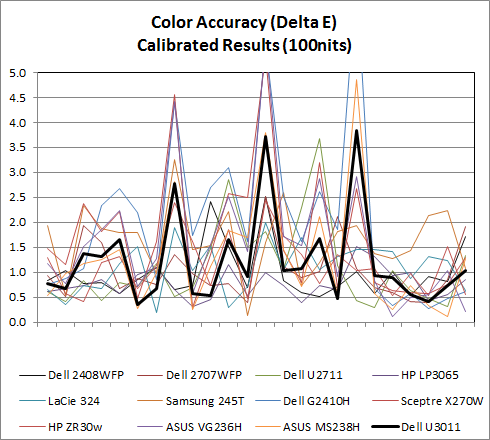
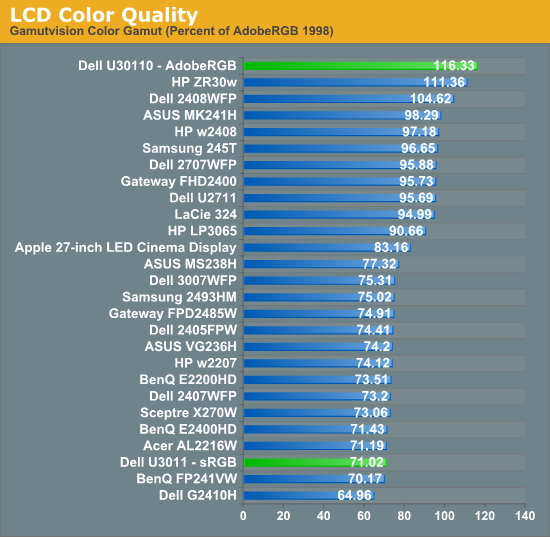

AdobeRGB Mode
sRGB Mode
Calibrated Delta-E is very good, though I'm still surprised the U3011 can't get under 1.0 on our tests. I'm starting to suspect that our i1D2 isn't quite as good as the Monaco Optix XR Pro, and have started looking for an i1Pro spectroradiometer as a result so we can have something more accurate going forward. That said, performance is still more than adequate for professional work. These two calibrations were performed in the sRGB mode at D65.
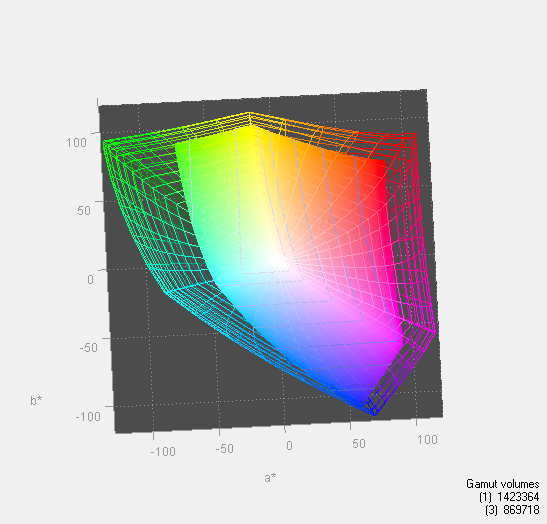
In addition, the U3011 has modes for AdobeRGB color space and sRGB in the OSD, something extremely useful for doing work and not getting oversaturation in applications that lack color management. You can immediately see the effect of those two modes in the color gamut measure above. Letting the monitor free to use its entire gamut of color, it leads the pack. Turn sRGB mode on, and it clamps down just nicely. 116.33% is also shockingly close to Dell's advertised 117% coverage of CIE 1796 (AdobeRGB), which is awesome to see confirmed above.








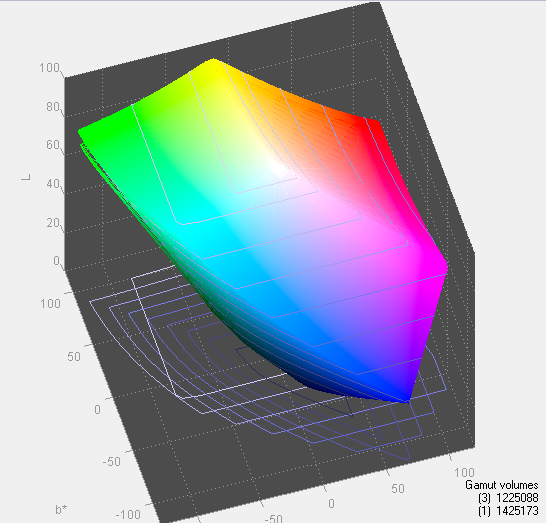
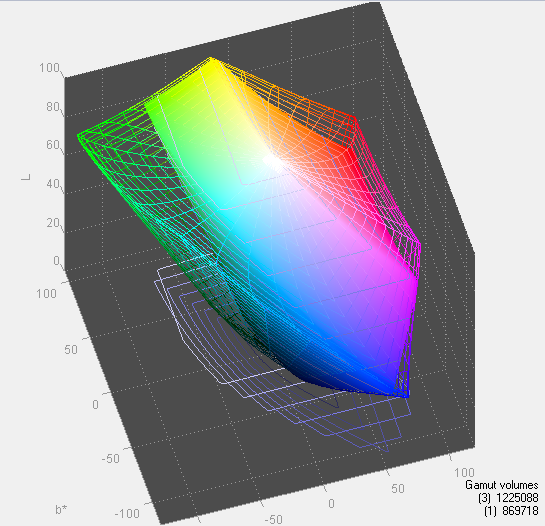








123 Comments
View All Comments
Sabresiberian - Friday, January 14, 2011 - link
Indeed! Thar's the thing I most want at this point; I hope manufacturers are reading your articles! Samsung? LG? Anyone listening?;)
mapesdhs - Friday, January 14, 2011 - link
Can this new Dell display accept a sync-on-green signal? How well does it handle lower
resolution inputs such as 1920x1200 or 1600x1200?
Such large displays don't seem to be quite there yet wrt quality and sensible pricing, so I
went with a 24" HP LP2475W (HIPS version).
Ian.
flblws - Friday, January 14, 2011 - link
how much? $1300? and still has a VGA port? REALLY?AND
and no 120HZ or 240HZ ?
Really?
yawn....
cjl - Saturday, January 15, 2011 - link
No monitor with this res will have 120Hz (or higher) anytime soon - the bandwidth just isn't there over DVI, HDMI, or DisplayPort (though the latest DisplayPort might just about be good enough - I'm not completely positive). As for the VGA port, some people still have laptops with only a VGA output. Obviously, it isn't meant to be the primary input, but it is there as an option (among the enormous number of other inputs).DanNeely - Saturday, January 15, 2011 - link
VGA is there because it costs next to nothing to add, but you can forget running native resolution over it. I tried once by accident (my GPU decided to send analog video over a DVI-I cable) to my NEC 3090, and the result was a ghastly mess. My initial reaction was to wonder if my monitor was DOA.AnnonymousCoward - Saturday, January 15, 2011 - link
DP1.2 x4 has the bandwidth for 2560x1600, 30-bit, 120Hz. All techs have the bandwidth for 120Hz at lower res.Soldier1969 - Saturday, January 15, 2011 - link
Well you keep on yawning my poor friend ill keep playing with maximum eye candy at 1600p. I have a 55 inch LED Sony 240hertz for everything else and a second 120hertz 37inch Samsung panel next to my 30 incher for double duty. Meanwhile you keep playing on your puny panel. You need to get educated on the tech or just keep showing your ignorance. You get what you pay for. If you want to play at the best res there is for PCs then get one otherwise just keep playing with TN panel garbage that keeps being churned out for the poor folk that think its good as it gets.Luay - Saturday, January 15, 2011 - link
Everyone is comparing the HP to the Dell but has anyone heard of Hazro?I'm sure a little attention to this company and its products will encourage them to venture into other markets. review please!
https://www.hazro.co.uk/shop.html#ecwid:category=4...
MeanBruce - Saturday, January 15, 2011 - link
With do many tech groups claiming to be delivering exactly what their customers were asking for let's hope someone from Dell Monitor Design reads Anandtech or at least these many comments. Everyone seems to be in agreement on the lack of RBG LED and DisplayPort 1.4 for this flagship design. There is hope though, Dell is due to replace the U2410 this year with the U2412, and in the past has introduced it's latest developments on the 24in platform then later they appear on the 27 and 30. So let's hope the new 24inch Ultrasharp is everything we have come to expect from Dell panels, and hey throw in a remote to control all inputs and the OSD and volume on the Soundbar. For all that I would have no problem with a $699 or $799 pricetag, they already make three other 24inch monitors at very low price points. Give the rest of us what we want!MeanBruce - Saturday, January 15, 2011 - link
Even $899, if it's Drop Dead Gorgeous!Peace Brothers!